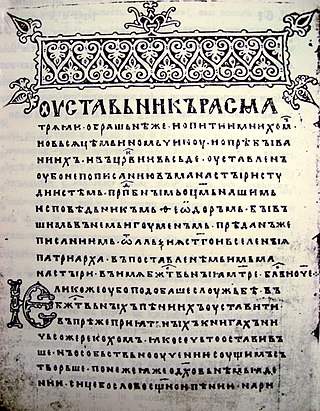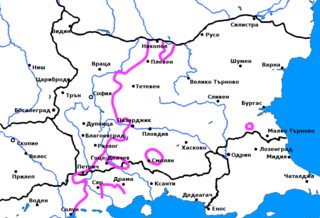
Old Church Slavonic or Old Slavonic was the first Slavic literary language.

The South Slavic languages are one of three branches of the Slavic languages. There are approximately 30 million speakers, mainly in the Balkans. These are separated geographically from speakers of the other two Slavic branches by a belt of German, Hungarian and Romanian speakers.

The history of the Bulgarian language can be divided into three major periods:
The term Maleševo-Pirin or Maleshevo-Pirin or Pirin-Maleshevo dialect is used in South Slavic linguistics to refer to a group of related varieties that are spoken on both sides of the border of Bulgaria and the Republic of North Macedonia. Some linguists treat them as dialects of the Bulgarian language, while Victor Friedman views them as part of Macedonian. According to some authors, they are linguistically transitional between the two national languages, Bulgarian and Macedonian and form part of the larger dialect continuum between them. The dialect group is named after the mountain ranges of Pirin in Bulgaria and Maleševo in Macedonia. When referring specifically to the dialects on the Bulgarian side, the term Petrich-Blagoevgrad dialect, after the two major towns in the area, is also used.

The Ser-Drama-Lagadin-Nevrokop dialect is a dialect currently treated both in the contexts of the southeastern group of Bulgarian dialects and the southeastern subgroup of dialects of the Macedonian. Prior to the codification of standard Macedonian in 1945, the dialects of Macedonia were classified as Bulgarian. The dialect is dynamic and is well known for the shortening of the words, and also characterised by the excessive use of for the Proto-Slavic yat even in cases where standard Bulgarian has, a feature which is typical for a number of dialects spoken in southern and southwestern Bulgaria . The Ser-Drama-Lagadin-Nevrokop dialect is closely related to the neighbouring dialects. It is closer to all Eastern Bulgarian dialects than to all Western. Macedonian shares much less features with the dialect than it does with the Maleševo-Pirin dialect of Macedonian and Bulgarian. Some Bulgarian dialects are more similar to Macedonian than the Ser-Nevrokop dialect, the Samokov dialect shares more features with Macedonian than both the Ser-Nevrokop and the Pirin-Malasevo dialects do, even though it is not considered a Macedonian dialect, the most of the western Bulgarian dialects and the Smolyan dialect share more similarities with Macedonian than the Ser dialect does. The Samokov dialect, most remarkably, shares with Macedonian and the Maleševo-Pirin dialect—the "to be" verb for future tense—"ke", which in contrast is "shte" in the Ser-Nevrokop dialect and in the Bulgarian language. The Yat border passes through the Maleševo-Pirin dialect and divides it on such a way that in the northern area of the dialect the yat is pronounced "e" and in the south—"ya". In the Ser-Nevrokop dialect the yat is pronounced in most places "ya", therefore the city of Serres, after which the dialect is named, is called "Syar" by the locals, as opposed to "Ser" in Macedonian. The first person singular is as in Bulgarian, ending with "a" or "am" as opposed to the constant "am" in Macedonian and the Bulgarian Smolyan dialect. The words for man -"m'zh" and for a dream "s'n" are as in Bulgarian, unlike the Macedonian "mazh" and "son". The words for night and tear—"nosht" and "s'lza" are as the Bulgarian, unlike the Macedonian "nok" and "solza".

The Balkan dialects are the most extensive group of dialects of the Bulgarian language, covering almost half of the present-day territory of Bulgaria. Their range includes north-central Bulgaria and most of the Bulgarian part of Thrace, excluding the Rhodopes, the region of Haskovo and Strandzha. As a result of the mass population movements that affected eastern Bulgaria during the 19th and the beginning of the 20th century, the Balkan dialects are now spoken also in vast areas of northeastern Bulgaria, especially the regions of Dobrich and Varna. The most significant feature of the dialects, as in most Eastern Bulgarian dialects, is the pronunciation of Old Church Slavonic ѣ (yat) as or, depending on the character of the following syllable. The Balkan dialects, and in particular, the Central Balkan dialect, lie at the foundation of formal Bulgarian. However, they are not identical to the standard language because many of its features derive from the Western Bulgarian dialects, including the Macedonian dialects, or are a compromise between Eastern and Western standard.

The Subbalkan dialect is a Bulgarian dialect, which is part of the Balkan group of the Eastern Bulgarian dialects. Its range includes the northeastern part of Bulgarian Thrace, i.e. the regions of Burgas, Sliven, Yambol, Stara Zagora and Chirpan. As a result of the mass population movements that affected eastern Bulgaria during the 19th and the beginning of the 20th century, speakers of the Subbalkan dialect have moved en masse to northeastern Bulgaria and now form a vast portion of the population of the districts of Varna, Dobrich and Balchik. Some of these also went as far as Bessarabia establishing numerous colonies there. Nowadays, a large part of the Bessarabian Bulgarians speak this dialect. The most significant feature of the Subbalkan dialect, as in all Balkan dialects, is the pronunciation of Old Church Slavonic ѣ (yat) as or, depending on the character of the following syllable.
The Pirdop dialect is a Bulgarian dialect, which is part of the Balkan group of the Eastern Bulgarian dialects. Its range includes the towns of Pirdop, Zlatitsa and Koprivshtitsa, as well as several neighbouring villages. The most significant feature of the dialect, as in all Balkan dialects, is the pronunciation of Old Church Slavonic ѣ (yat) as or, depending on the character of the following syllable. However, the Pirdop dialect also features a number of characteristics which bring it closer to the neighbouring Western Bulgarian dialects, and especially to the Botevgrad dialect and which, in turn, separate it from the rest of the Balkan dialects.

The Rup dialects, or the Southeastern dialects, are a group of Bulgarian dialects located east of the yat boundary, thus being part of the Eastern Bulgarian dialects. The range of the Rup dialects includes the southern part of Thrace, i.e. Strandzha, the region of Haskovo, the Rhodopes and the eastern half of Pirin Macedonia.
The Zlatograd dialect is a Bulgarian dialect, member of the Rup or Southeastern Bulgarian dialects. The Zlatograd dialect is spoken in the southwestern part of the Eastern Rhodopes, i.e. in the town of Zlatograd, as well as a number of neighbouring villages and towns, e.g. Nedelino, Kirkovo, etc. The Zlatograd dialect is most closely related to the eastern and western Rup dialects, but also shares a number of phonological and morphological characteristics with the Rhodopean dialects. Thus, it is usually considered to be transitional between the two groups.
The Babyak dialect is a Bulgarian dialect, member of the Rup or Southeastern Bulgarian dialects. It is spoken in several mountainous villages on the western fringes of the Rhodopes and is thus sandwiched between the Chepino dialect on the east and northeast and the Razlog dialect to the south and west. It shares a number of phonological characteristics with both the Rup and the Southwestern dialects. Because of its specific reflexes of Old Church Slavonic yat, it is generally classified as a Rup dialect but is actually transitional between the two dialectal groups.
The Razlog dialect is a Bulgarian dialect, member of the Rup dialects. Its range includes the valley of Razlog in southwestern Bulgaria and its immediate neighbours are the Rup Serres-Nevrokop dialect to the south, the Babyak dialect to the east, the Samokov and Ihtiman dialects to the north and the Blagoevgrad-Petrich dialect to the west. It shares a number of phonological characteristics with both the Rup and the Southwestern dialects. This is the dialect through which the Bulgarian language became known to modern science, because in 1822 the creator of the modern Serbian language Vuk Karadžić published in Vienna Dodatak k sankpeterburgskim sravnitelnim rijechnicima sviju jezika i narijechija s osobitom ogledom Bugarskog jezika ;("An addition to the St. Petersburg comparative dictionaries of all languages and dialects with a particular sample of the Bulgarian language"), in which are placed 273 words, a short grammar, 27 folk songs and 2 chapters of the gospel, which he wrote and said to him pravi bugarin iz Razloga;("a real Bulgarian from Razlog").
The Botevgrad dialect is a Bulgarian dialect, member of the Southwestern Bulgarian dialects, which is spoken in the region of Botevgrad and Etropole in northwestern Bulgaria. It is located on the yat boundary and is closely related to the Eastern Bulgarian Pirdop dialect.
The Ihtiman dialect is a Bulgarian dialect, member of the Southwestern Bulgarian dialects, which is spoken in the regions of Ihtiman, Kostenets and Septemvri in central western Bulgaria. It is transitional between the Botevgrad and Samokov dialect.
The Sofia dialect is a Bulgarian dialect, member of the Southwestern Bulgarian dialects, which is spoken in western part of the Sofia valley by part of the Shopi. Its immediate neighbours are the Vratsa dialect to the north, the Elin Pelin dialect to the east, the Transitional dialects to the west and the Samokov dialect to the south.
The Samokov dialect is a Bulgarian dialect, member of the Southwestern Bulgarian dialects, which is spoken in the region of Samokov in central western Bulgaria. Its immediate neighbours are the Sofia dialect and Elin Pelin dialect to the north, the Ihtiman dialect to the east, the Dupnitsa dialect to the west and the Razlog dialect to the south.
The Dupnitsa dialect is a Bulgarian dialect, member of the Southwestern Bulgarian dialects, which is spoken in the region of Dupnitsa in central western Bulgaria. It is transitional between the Samokov dialect to the east and the Blagoevgrad-Petrich dialect to the south.
The Kyustendil dialect is a Bulgarian dialect, member of the Southwestern Bulgarian dialects, which is spoken in the region of Kyustendil in central western Bulgaria. It borders on the Transitional dialects to the north, the Dupnitsa dialect to the east and the Blagoevgrad-Petrich dialect to the south. It is closely related to the Dupnitsa dialect.
The Shumen dialect is a Bulgarian dialect, member of the Moesian dialects. It is one of the best preserved Moesian dialects and is spoken in the regions of Shumen and Kaspichan.
The Eastern South Slavic dialects form the eastern subgroup of the South Slavic languages. They are spoken mostly in Bulgaria and North Macedonia, and adjacent areas in the neighbouring countries. They form the so-called Balkan Slavic linguistic area, which encompasses the southeastern part of the dialect continuum of South Slavic.






